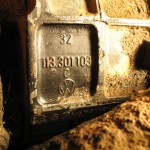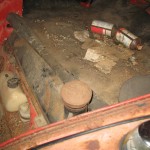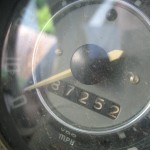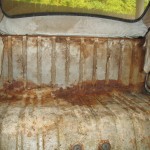Trying to identify the manufacture date or type of transmission takes a little work. You’d think the part number would do it (113 301 103 C), but it’s such a ubiquitous label for so many transmissions over so many years that you need to gather more information than that. Or, at least, I couldn’t find a list of part numbers that made it clear.
In addition to the part number, there is a serial number or stamping that can get you more information. On bugs built sometime after mine, the serial number is a date stamp. But it looks like mine is just a plain ole serial number (8624859).
Some people look inside the bottom of the transmission and actually count the number of gear teeth to find out exactly what they have. Reconstructing the history of a bug is a lot like archaeology. You dig and probe and re-evaluate what you know and what you think you know. It’s tempting to look at a crud-covered transmission and say that it’s the original transmission. But a lot can happen to a car over the 48 years of its life. Parts get replaced or swapped, or their internal gears and gadgets get upgraded or downgraded or whatever. Your transmission may be original, or it may have been swapped with a transmission from a ’61 VW (with its own family tree of parts) found in a junkyard in ’73. After a while the crud re-attaches, and everything gets normalized.























































